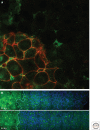Forming and interpreting gradients in the early Xenopus embryo
- PMID: 20066079
- PMCID: PMC2742078
- DOI: 10.1101/cshperspect.a002477
Forming and interpreting gradients in the early Xenopus embryo
Abstract
The amphibian embryo provides a powerful model system to study morphogen gradients because of the ease with which it is possible to manipulate the early embryo. In particular, it is possible to introduce exogenous sources of morphogen, to follow the progression of the signal, to monitor the cellular response to induction, and to up- or down-regulate molecules that are involved in all aspects of long-range signaling. In this article, I discuss the evidence that gradients exist in the early amphibian embryo, the way in which morphogens might traverse a field of cells, and the way in which different concentrations of morphogens might be interpreted to activate the expression of different genes.
Figures



Similar articles
-
Morphogen gradients, positional information, and Xenopus: interplay of theory and experiment.Dev Dyn. 2002 Dec;225(4):392-408. doi: 10.1002/dvdy.10170. Dev Dyn. 2002. PMID: 12454918 Review.
-
Visualizing long-range movement of the morphogen Xnr2 in the Xenopus embryo.Curr Biol. 2004 Nov 9;14(21):1916-23. doi: 10.1016/j.cub.2004.10.020. Curr Biol. 2004. PMID: 15530392
-
Negative regulation of Smad2 by PIASy is required for proper Xenopus mesoderm formation.Development. 2004 Nov;131(22):5613-26. doi: 10.1242/dev.01449. Epub 2004 Oct 20. Development. 2004. PMID: 15496439
-
Temporal dynamics of patterning by morphogen gradients.Curr Opin Genet Dev. 2009 Aug;19(4):315-22. doi: 10.1016/j.gde.2009.05.004. Epub 2009 Jul 10. Curr Opin Genet Dev. 2009. PMID: 19596567 Review.
-
Expression cloning of Xenopus Os4, an evolutionarily conserved gene, which induces mesoderm and dorsal axis.Dev Biol. 2001 Nov 1;239(1):118-31. doi: 10.1006/dbio.2001.0420. Dev Biol. 2001. PMID: 11784023
Cited by
-
Temporal control of BMP signalling determines neuronal subtype identity in the dorsal neural tube.Development. 2013 Apr;140(7):1467-74. doi: 10.1242/dev.090118. Epub 2013 Mar 5. Development. 2013. PMID: 23462473 Free PMC article.
-
Exosomes as secondary inductive signals involved in kidney organogenesis.J Extracell Vesicles. 2018 Jan 23;7(1):1422675. doi: 10.1080/20013078.2017.1422675. eCollection 2018. J Extracell Vesicles. 2018. PMID: 29410779 Free PMC article.
-
Centrin-2 (Cetn2) mediated regulation of FGF/FGFR gene expression in Xenopus.Sci Rep. 2015 May 27;5:10283. doi: 10.1038/srep10283. Sci Rep. 2015. PMID: 26014913 Free PMC article.
-
Quantitative analyses reveal extracellular dynamics of Wnt ligands in Xenopus embryos.Elife. 2021 Apr 27;10:e55108. doi: 10.7554/eLife.55108. Elife. 2021. PMID: 33904408 Free PMC article.
-
WNT signaling memory is required for ACTIVIN to function as a morphogen in human gastruloids.Elife. 2018 Oct 12;7:e38279. doi: 10.7554/eLife.38279. Elife. 2018. PMID: 30311909 Free PMC article.
References
-
- Albano RM, Godsave SF, Huylebroeck D, Van Nimmen K, Isaacs HV, Slack JMW, Smith JC 1990. A mesoderm-inducing factor produced by WEHI-3 murine myelomonocytic leukaemia cells is activin A. Development 110:435–443 - PubMed
-
- Asashima M, Nakano H, Shimada K, Kinoshita K, Ishii K, Shibai H, Ueno N 1990. Mesodermal induction in early amphibian embryos by activin A (erythroid differentiation factor). Wilhelm Roux' Archiv 198:330–335 - PubMed
-
- Birsoy B, Kofron M, Schaible K, Wylie C, Heasman J 2006. Vg 1 is an essential signaling molecule in Xenopus development. Development 133:15–20 - PubMed
-
- Boterenbrood EC, Nieuwkoop PD 1973. The Formation of the Mesoderm in Urodelean Amphibians. V. Its Regional Induction by the Endoderm. Wilhelm Roux' Archiv 173:319–332 - PubMed
Publication types
MeSH terms
Substances
Grants and funding
LinkOut - more resources
Full Text Sources
